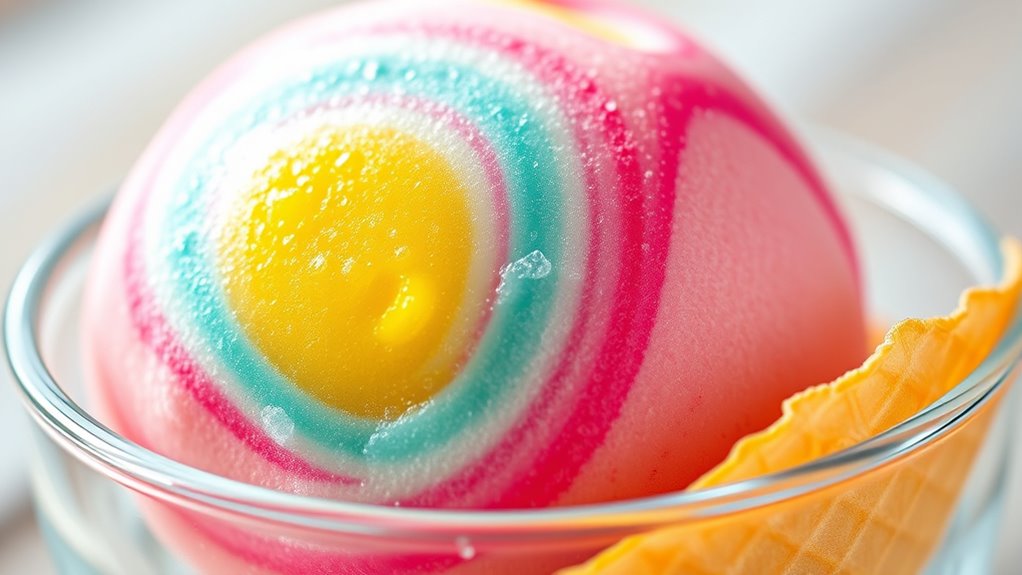Making sorbet is an art that combines fresh fruit, sugar, and sometimes citrus or alcohol to create a smooth, invigorating treat. By balancing sugar and fruit, you prevent large ice crystals, ensuring a soft, scoopable texture straight from the freezer. You don’t need fancy equipment—blenders work just fine. Master these techniques, and you’ll craft delicious, personalized sorbets perfect for warm days. Keep exploring, and you’ll discover how to perfect your frozen creations even further.
Key Takeaways
- Use fresh fruit purees combined with sugar syrup to create flavorful, smooth sorbet textures.
- Balance sugar content (20-30%) and add citrus or alcohol to enhance flavor and scoopability.
- No ice cream maker needed; blend frozen fruit for a creamy, consistent result.
- Proper freezing and blending techniques prevent icy or grainy textures.
- Experiment with fruits, herbs, and citrus to customize refreshing, personalized sorbet flavors.

Have you ever wondered how to create a perfectly smooth and flavorful sorbet at home? Making a sorbet, a fat-free frozen dessert, is simpler than you might think. The key lies in using fresh fruit puree combined with a well-balanced sugar syrup. The sugar not only sweetens the sorbet but also plays a vital role in controlling the freezing point, which prevents large ice crystals from forming and guarantees a smooth, scoopable texture.
Typically, a sugar concentration of about 20-30% is ideal, as it helps keep the dessert soft enough to serve without turning into an icy block.
When making sorbet at home, you don’t need fancy equipment. Instead, you can use a high-powered blender or food processor to crush frozen fruit directly. This method eliminates the need for an ice cream maker and produces a creamy, uniform texture.
For added flavor and brightness, a splash of citrus juice—like lemon or lime—can be incorporated. Citrus not only enhances the flavor but also helps balance the sweetness and adds a revitalizing tang that brightens the overall profile of your frozen treat.
Achieving the perfect texture is essential for a satisfying sorbet experience. The right sugar-to-fruit ratio lowers the freezing point, which prevents the formation of large ice crystals that can ruin the smoothness.
The goal is to create a dessert that feels soft and easy to scoop straight from the freezer, not icy or grainy. Incorporating a small amount of alcohol, such as vodka or liqueur, can further improve the texture. Alcohol depresses the freezing point slightly, keeping the sorbet soft and scoopable without compromising its structure or flavor.
The beauty of making sorbet at home is the endless variation you can create. By choosing different fruits, adjusting the level of sweetness, and experimenting with citrus or herbs, you can craft a revitalizing dessert tailored to your taste.
Whether it’s a vibrant berry, tropical mango, or zesty citrus, each combination offers a unique flavor profile. The process of blending fruit puree with sugar syrup and freezing it just right results in a delightful frozen dessert that’s light, invigorating, and perfect for warm days or any time you crave a cool treat.
In addition, understanding Hyundai Tuning concepts can inspire creative ways to customize your kitchen equipment for better results, such as optimizing blending or freezing techniques for perfect texture.
Frequently Asked Questions
Is Sorbet Healthier Than Ice Cream?
You might wonder if sorbet is healthier than ice cream. Generally, it’s because sorbet contains less fat, cholesterol, and calories since it’s dairy-free and made without cream or eggs. It’s a good choice if you want a lower-fat, dairy-free treat.
However, keep in mind that sorbet often has more sugar, so eating it in moderation helps you enjoy its health benefits without overdoing the sugar intake.
What Are the Benefits of Sorbet?
Think of sorbet as a burst of sunshine on a hot day. Its benefits include being fat-free and lower in calories, helping you enjoy a sweet treat without guilt.
You get a boost of vitamin C and antioxidants, supporting your immune health.
Plus, it’s vegan and dairy-free, making it a versatile, invigorating option that satisfies your cravings while nourishing your body.
What’s the Difference Between Sorbet and Granita?
You might wonder about the difference between sorbet and granita. Sorbet is smoother and creamier because it’s blended thoroughly, resulting in a uniform texture similar to ice cream but dairy-free.
Granita, on the other hand, has a coarser, crystalline texture from periodic scraping during freezing, giving it a slushy, icy feel.
Both are fruit-based and dairy-free, but their textures and preparation methods set them apart.
What Is the Science Behind Sorbet?
Did you know that sugar lowers the freezing point of water by up to 1.86°C per 10% increase in concentration? This science behind sorbet’s texture involves freezing point depression, where sugars and alcohol prevent large ice crystals, creating a smooth, creamy feel.
As you freeze and churn, smaller ice crystals form, and the right balance of ingredients ensures your sorbet stays soft, scoopable, and invigoratingly delicious.
Conclusion
As you explore the art of sorbet, remember that it’s more than just a invigorating treat—it’s a perfect example of how simple ingredients can create complex flavors. Some say sorbet’s origins prove that natural, fruit-based desserts can stand on their own without added fats or dairy. This theory holds true, showing that purity and freshness truly shine in every scoop. So, next time you enjoy sorbet, appreciate the skill and history behind this vibrant, delicious art form.









